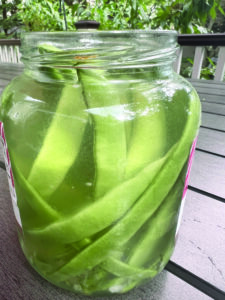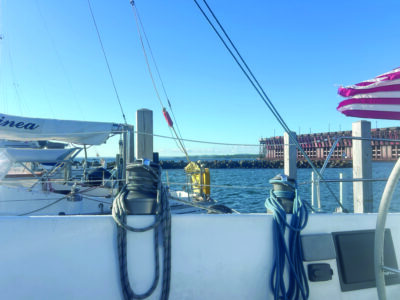Outdoors North: The powerful peace in being alone

JOHN PEPIN
“I’ll be waiting here just for you, just for you and September days, it feels like years away,” – Mike Delevante
This graveled two-track road doesn’t appear on state highway maps.
Its existence presents only a faint trace of straight stretches and rounded corners set into this bucolic landscape when viewed from above.
To find it, you’ve got to roll off the big skyway highway and then past a strange intersection that is two parts side road and five parts parking lot.
From there, you ride past old farmhouses and homesteads that look to have been built during the early part of the last century.
The road then starts twisting, as though you are following a watercourse, but it doesn’t appear that you really are.
The topography changes, and the surroundings now include a great number of cedars, spruces and other trees indicative of moist environments.
Still moving, the road rounds several corners and climbs.
As it does, the embankment on the driver’s side of the road falls away to an impressive drop of at least a hundred feet.
When the road dead ended into an intersection, we took the left-hand turn and followed a narrower version of this dirt road to an even fainter right-hand turn. From there, we traveled the road through a swamp.
It was clear from the surroundings that the creek we were looking for wouldn’t be too far down this old road. In a couple of miles, we found it.
At a country bridge, we pulled off down a very short muddy road that led to a clearing where we parked the Jeep.
When we opened the doors, we heard water rushing. We walked toward the sound and found a deep and clear creek pooled at the head of a split in the stream, where the creek transitioned to rapids.
The day was warm and bright.
I was wearing shorts, my favorite Navy-blue T-shirt that is starting to tear in places at the end of its long life and blue, rubber flip-flops. The Queen of Shebis, who was with me on this late summer outing, was also dressed for a summery day, but she was wearing shoes and what I call “baby socks.”
After she took my suggestion to remove her shoes so we could wade together in the creek, I stepped into the water and found that it was incredibly cold for this time of the year. Clearly, this was a spring-fed creek.
The water was cold enough that the Queen retreated to the creek bank after only a short walk, as I moved downstream to the head of the rapids. I had my fishing rod with me, and I took a couple of casts, getting a single bite as I retrieved a spinner through the cold, fast water.
About halfway through the split set of rapids, that were moving over thousands of multi-colored rocks, the water disappeared under an incredible log and debris jam that stood like a wall, about 30 feet high.
My mind quickly drew pictures of the depth and wildness the creek would have experienced as it floated those tall, heavy trees down this creek.
The realization was astonishing.
The logjam was so massive that it stretched across the entire creek course, preventing me or anyone else from passing without climbing over the top or slogging through the thick woods along the sides of the creek.
We knew we wouldn’t be doing either of those things on what we had planned as a relaxing early Saturday afternoon.
Instead, we walked around a couple of big puddles as we went back up the road to the bridge. The Queen spotted a small toad about the size of her thumbnail taking a dip in the chocolate-colored water.
At the bridge, the creek was flowing wide and shallow. In the trees overhanging the creek, there were red-breasted nuthatches making “tooting” sounds as they flew from tree to tree.
We also heard a black-and-white warbler but didn’t see it.
Upstream, the creek deepened into a nice corner hole at a big boulder. This looked like one of what I presumed would be numerous trout fishing holes along this watercourse, if we were to whack our way through the bushes to find them.
Another day, perhaps.
We walked back to the waiting Jeep. We got in and started heading back down the marsh road. We passed several intersections before we made our way to the highway.
At 65 mph, the Queen let me keep the windows down. We felt the warm air blow through the vehicle. Neither one of us wanted the confinement necessary for the air conditioning.
We wanted the freedom and pleasure of the day to move as much summertime as possible from outside the vehicle to the inside, where we were quite comfortable.
It was 75 degrees, a temperature the Queen said was “perfect.”
The warm breeze messed our hair out of place. We didn’t care.
A few miles down the road, we turned off to find a campground and a boating access site. I pulled the Jeep up at the concrete ramp and got out with my fishing pole. I quickly waded into comparatively warm water.
The bottom of the lake was covered in gravel. Out in the distance in front of me, fish rose to the surface, breaking the flat, mirrorlike look of the water.
When the water depth got to the bottom of my shorts, I stopped walking and began casting my spinner out as far as I could. I didn’t get any bites, but it felt so good to be standing in that cool water with the warm air all around me.
The Queen didn’t wade in with me or cast. She said she enjoyed just standing at the edge of the lake watching the bugs whizzing around on the water surface.
After we began to hear children’s voices getting louder from a nearby swimming beach, and a pickup truck that needed a muffler huffing and puffing its way throughout the campground to the boat ramp, we decided to leave.
We were just “bumming around,” enjoying the day.
About 15 miles later, we had turned onto a first-paved and then-graveled road that allowed us to leave the highway behind us for a pleasant backroad trip through forests, fields and plains, experiencing great vista views and impressive elevations.
The Queen started to drift off into a car ride nap, as she often does when she’s comfortable. She woke up when I stopped the car near a bridge over a wide river.
We got out of the Jeep to look.
I told her to prepare herself for both sides of the bridge to offer incredible viewing.
We checked the downstream side first.
Big boulders were sticking up from the water, with the river in late season form, a little choked out from the heat and only limited rainfall recently. It remained wildly picturesque.
The upstream side showed a split into two channels. In one channel, the water rushed through rapids while both waterways reflected the beautiful blue sky.
We looked straight down from the bridge and saw more logs and debris clogged around a couple of the bridge piers.
It wasn’t anywhere near as extensive as we had found at the creek, but it still clearly demonstrated that this river too could get wild and high and dangerous.
We both agreed that it would be incredible to be at this spot to witness spring snowmelt.
Another day, perhaps.
We stopped at a gas station for a bathroom, a candy bar and a cold pop on the way back home.
When we got there, we still had plenty of time left in the day for me to cut the grass and take my lovely traveling bride to Dairy Queen for a mint Oreo blizzard and some onion rings.
When we left the house that morning, we stepped out into what seemed like it was going to be a tremendous summertime day.
It was that for sure.
But I think we also found one of those times when everything seemed to be as close to perfect as we could have asked for. It was one of those days that I suspect I will return to in my memory over the many long days of winter.
Sometimes, being out in nature is defined by the powerful peace there is in being alone. There are other times, like this one, when the moments are made better through experiencing them with a beloved companion.
Nature is almost never a wonderful experience for me when the group size surpasses five or six.
People like to talk a lot, and we expect each other to not only listen, but to offer reactions to our grand and important pronouncements.
I think I’d rather change baby diapers all day.
Outdoors North is a weekly column produced by the Michigan Department of Natural Resources on a wide range of topics important to those who enjoy and appreciate Michigan’s world-class natural resources of the Upper Peninsula.




